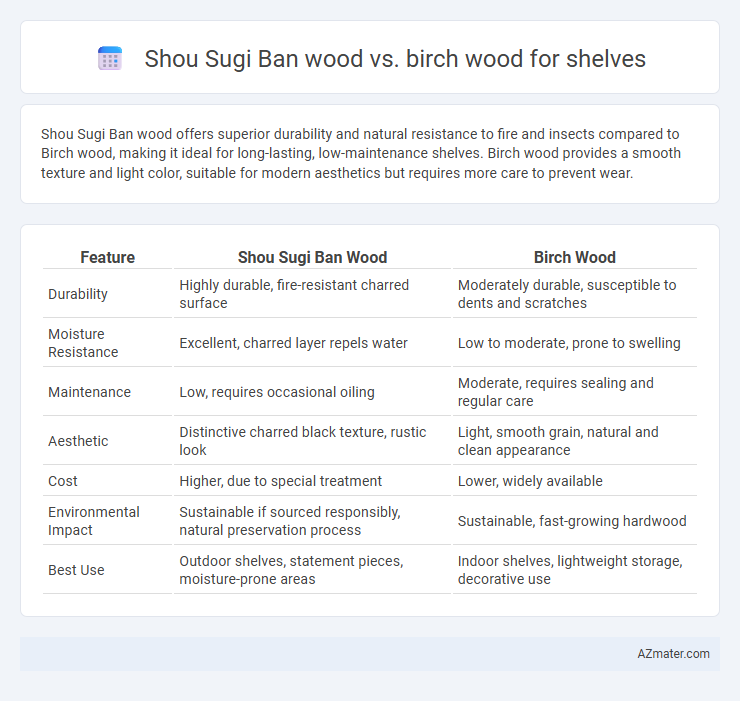Shou Sugi Ban wood offers superior durability and natural resistance to fire and insects compared to Birch wood, making it ideal for long-lasting, low-maintenance shelves. Birch wood provides a smooth texture and light color, suitable for modern aesthetics but requires more care to prevent wear.
Table of Comparison
| Feature | Shou Sugi Ban Wood | Birch Wood |
|---|---|---|
| Durability | Highly durable, fire-resistant charred surface | Moderately durable, susceptible to dents and scratches |
| Moisture Resistance | Excellent, charred layer repels water | Low to moderate, prone to swelling |
| Maintenance | Low, requires occasional oiling | Moderate, requires sealing and regular care |
| Aesthetic | Distinctive charred black texture, rustic look | Light, smooth grain, natural and clean appearance |
| Cost | Higher, due to special treatment | Lower, widely available |
| Environmental Impact | Sustainable if sourced responsibly, natural preservation process | Sustainable, fast-growing hardwood |
| Best Use | Outdoor shelves, statement pieces, moisture-prone areas | Indoor shelves, lightweight storage, decorative use |
Introduction: Shou Sugi Ban Wood vs Birch Wood for Shelves
Shou Sugi Ban wood offers exceptional durability and natural fire resistance due to its traditional Japanese charring technique, making it ideal for long-lasting, weather-resistant shelves. Birch wood provides a smooth, light-colored finish with fine grain patterns, favored for its affordability and ease of customization in indoor shelving. Both woods differ significantly in texture, lifespan, and maintenance needs, influencing the choice based on environmental conditions and aesthetic preference.
What is Shou Sugi Ban?
Shou Sugi Ban is a traditional Japanese woodworking technique that involves charring the surface of wood, typically cedar, to increase its durability and resistance to insects and decay, making it ideal for shelf applications requiring longevity. Compared to birch wood, which is smooth, pale, and less resistant to moisture and pests, Shou Sugi Ban wood offers a striking, textured, and darkened finish that enhances both aesthetics and functionality. This method creates a protective carbon layer, extending the shelf's lifespan while providing a unique rustic and elegant appearance unmatched by untreated birch wood.
Characteristics of Birch Wood
Birch wood is renowned for its fine, even grain and light color, making it highly versatile and aesthetically appealing for shelf construction. It possesses moderate hardness and good shock resistance, ensuring durability and strength for holding various items. Birch is also easy to finish and stain, allowing for a smooth surface and customizable appearance compared to the charred, textured surface of Shou Sugi Ban wood.
Durability Comparison: Shou Sugi Ban vs Birch
Shou Sugi Ban wood offers superior durability compared to birch wood due to its charred surface, which provides enhanced resistance to moisture, pests, and decay. Birch wood, while strong and attractive, is more prone to dents, scratches, and water damage over time, making it less ideal for high-use shelving. The carbonized finish of Shou Sugi Ban extends the wood's lifespan significantly, ensuring a longer-lasting and low-maintenance shelf option.
Visual Appeal and Aesthetic Differences
Shou sugi ban wood features a distinct charred surface with deep black textures and a tactile, matte finish that highlights the grain patterns, creating a striking, rustic, and modern aesthetic ideal for statement shelves. Birch wood offers a lighter, smooth, and uniform appearance with soft, warm tones and subtle grain variations that lend a clean, Scandinavian-inspired look perfect for minimalist or contemporary shelf designs. The visual contrast between the dramatic, textured Shou sugi ban and the gentle, polished look of birch defines their aesthetic suitability for different interior styles and ambiance.
Maintenance and Longevity
Shou sugi ban wood, charred for enhanced durability, offers superior resistance to moisture, insects, and rot, requiring minimal maintenance compared to Birch wood. Birch wood, though aesthetically pleasing, demands regular sealing and protection to prevent warping and decay over time. Shelves crafted from Shou sugi ban provide longer-lasting structural integrity, making them ideal for environments prone to humidity and wear.
Environmental Impact and Sustainability
Shou sugi ban wood, a traditional Japanese technique involving charring cedar, offers enhanced durability and natural weather resistance, reducing the need for chemical treatments and extending shelf lifespan, which contributes to sustainability. Birch wood, commonly sourced from fast-growing species, is renewable and biodegradable, but typically requires more frequent replacing or finishing, potentially increasing environmental impact. Choosing shou sugi ban wood for shelves can result in lower maintenance and longer usability, aligning better with eco-friendly and sustainable practices.
Cost Comparison: Shou Sugi Ban vs Birch Shelves
Shou Sugi Ban wood shelves typically cost more than birch wood due to the labor-intensive charring process that enhances durability and resistance to pests and fire. Birch shelves, often more affordable, provide a smooth finish and consistent grain but may require additional treatments to improve longevity. Choosing between the two depends on budget priorities and desired shelf durability.
Best Applications for Each Wood Type
Shou sugi ban wood, known for its charred surface and enhanced weather resistance, is ideal for outdoor shelves or accent pieces requiring durability and a striking aesthetic. Birch wood, valued for its smooth texture and light color, is perfect for indoor shelves where a clean, modern look and ease of finishing are desired. Each wood type excels in its respective application: Shou sugi ban for rugged, weatherproof use and Birch for refined, indoor environments.
Conclusion: Choosing the Right Wood for Your Shelves
Shou sugi ban wood offers superior durability and natural resistance to moisture and pests due to its charred surface, making it ideal for long-lasting shelves in humid or high-traffic areas. Birch wood provides a smooth, light finish with excellent workability and affordability, suitable for decorative shelves in low-moisture environments. Selecting between Shou sugi ban and Birch wood depends on the desired aesthetic, durability requirements, and environmental conditions for your shelving project.

Infographic: Shou sugi ban wood vs Birch wood for Shelf
 azmater.com
azmater.com